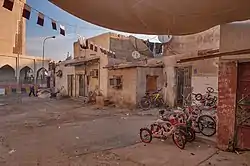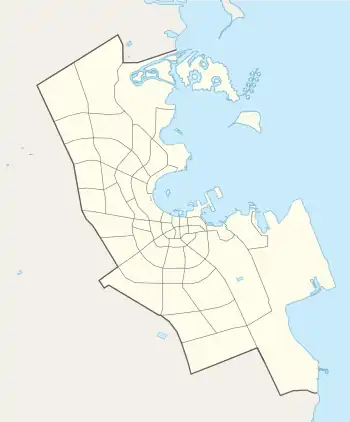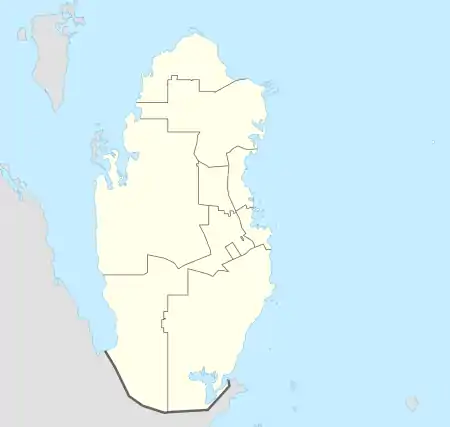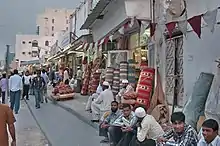Al Najada
النجادة | |
|---|---|
District | |
 Sikkat Al Ihsan Street in Al Najada | |
 Al Najada  Al Najada | |
| Coordinates: 25°17′N 51°31.8′E / 25.283°N 51.5300°E | |
| Country | |
| Municipality | Ad-Dawhah |
| Zone | Zone 5 |
| District no. | 5 |
| Area | |
| • Total | 0.05 km2 (0.02 sq mi) |
Al Najada (Arabic: النجادة) is a district in Qatar, located in the municipality of Doha.[2] It is one of the oldest districts of Doha.[3] Doha's rapid urbanization during the 1970s after it gained independence resulted in the gradual decline of Al Najada. Several of its historical buildings have been demolished.[3]
The Qatar Museums Authority has taken steps to preserve the cultural and architectural heritage of the district with its 'Al Turath al Hai' ('living heritage') initiative.[4] Most significant structures dating back to the early 20th century that still exist have been documented by the Origins of Doha Project. Some of the contemporary buildings dating to the late 20th century were intentionally designed with traditional elements of Qatari architecture in the interests of preserving the district's identity.[5]
Geography
Al Najada borders the following districts:[6]
- Barahat Al Jufairi to the south, separated by Barahat Al Jufairi Street.
- Old Al Ghanim to the east, separated by Grand Hamad Street.
- Al Jasrah to the north, separated by Ali Bin Abdullah Street.
- Mushayrib to the west.
Landmarks

Najada Souq
Najada Souq, also known as the Mobile Phone Souq, was closed in 2012. It was announced in 2017 that the souq would re-open.[7] A gold market containing 50 shops was inaugurated in the refurbished Najada Souq in July 2018. The new souq has an underground parking lot with 250 spaces.[8]
Sikkat Al Ihsan
Sikkat Al Ihsan is a tapered street that connects Al Maymoun Street and Barahat Al Jufairi Street. Most of the residential units on this street are old, likely dating to the early 20th century, and provide good examples of vernacular architecture in Doha. Because of its long and mostly-undisturbed history, Sikkat Al Ihsan is considered a significant historic site of interest.[9]
Windtower house
Windtowers are structures built to direct airflow in buildings. In the past, they were a common occurrence in Qatar, however, the rapid modernization of Doha has seen all other windtowers in the city demolished, leaving Al Najada's windtower as the last surviving one in Qatar's capital.[10] Situated inside the Najada Souq complex, the house once served as an ethnographic museum but has since been closed to the public.[11]
References
- ↑ "District Area Map". Ministry of Development Planning and Statistics. Retrieved 11 February 2019.
- ↑ "2010 population census" (PDF). Qatar Statistics Authority. Archived from the original (PDF) on 2 April 2015. Retrieved 29 June 2015.
- 1 2 Djamel Bouassa. "Al Asmakh historic district in Doha, Qatar: from an urban slum to living heritage". academia.edu. Retrieved 10 July 2015.
- ↑ "The Winners of the Old Doha Prize Competition Announced". Marhaba. 26 November 2013. Archived from the original on 27 September 2018. Retrieved 10 July 2015.
- ↑ Daniel Eddisford; Kirk Roberts (June 2014). "Historic Building Survey Report" (PDF). Origins of Doha Project. p. 41. Retrieved 27 August 2018.
- ↑ "District map". The Centre for Geographic Information Systems of Qatar. Archived from the original on 24 November 2020. Retrieved 30 November 2019.
- ↑ "Qatar's Old Souq Najada Is Getting a Makeover". expatwoman.com. 30 January 2017. Retrieved 27 August 2018.
- ↑ "New Gold Souq housing 50 shops opens at Souq Najada". Gulf Times. 2 July 2018. Retrieved 27 August 2018.
- ↑ Daniel Eddisford; Kirk Roberts (June 2014). "Historic Building Survey Report" (PDF). Origins of Doha Project. p. 30. Retrieved 27 August 2018.
- ↑ Benna, Umar G.; Garba, Shaibu Bala (7 June 2016). Population Growth and Rapid Urbanization in the Developing World. IGI Global. p. 182. ISBN 9781522501886.
- ↑ "Windtower House". Explore Qatar. Retrieved 8 November 2019.